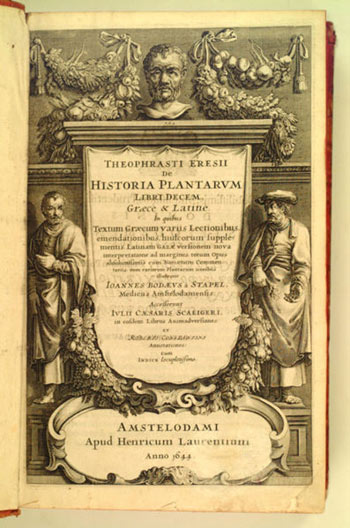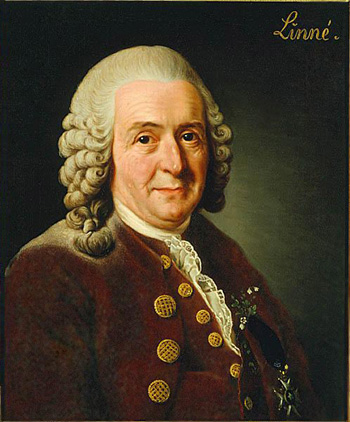
Plant Taxonomy - Part 1
Marion Jarratt
Note: This article originally appeared in 'Brigge', the newsletter of the friends of Burrendong Arboretum. The Arboretum is located in the central west of New South Wales, near Wellington.
Visit the Burrendong Arboretum website
Plant Taxonomy: [principles of] classification especially in biology, or, in one reference,
"the science of naming [plants]"
The history of plant taxonomy is a long one and reflects the needs and philosophical concepts of society in different periods and the level of knowledge and technology of that society. [Here I must confess that I am dealing only with the history of plant taxonomy in the western world. The story of taxonomy in other cultures such as oriental and Islamic would be a fascinating subject and you may eventually get a serve on that as well!].
We know, from present day indigenous people, that the pre literate hunter/gatherer was very aware of different plants and could name many hundreds based on practical properties such as their use for medicine, food, shelter, and their potential to harm. However knowledge [and names] remained essentially local. The need was practical and science and technology were non-existent.
| |
 |
| |
The frontispiece to an illustrated 1644 edition of Historia Plantarum by the Greek philosopher Theophrastus |
The domination of Greece in the ancient world with its concomitant of stability and wealth, the growth of cities and the increasing appreciation of education and art introduced an entirely new scenario. Logic and reasoning were emphasised and this was reflected in the approach to the plant world. Theophrastus [370-285 BC] classified plants by form - trees, shrubs, undershrubs herbs, - then by longevity annuals, biennials perennials - and finally by floral morphology eg superior and inferior ovaries. His was the first attempt to impose some kind of order on nature and he has been called the 'Grandfather of Botany'.
Dioscorides [a Greek physician in the Roman Army in the 1st Century AD] classified and described the medicinal qualities of 600 kinds of plants, grouping many members of currently recognised families. His book. Materia Medica, was the main source of medical information for the next 1,000 years and any person who had a copy [and could read] was guaranteed success and fortune!
The political and cultural disruption that afflicted Christian Europe for centuries after the collapse of Rome meant society was in a constant state of flux. There were few opportunities or incentives for original science or observation. Essentially plant taxonomy returned to the practical requirements of a hunter/gatherer era. The manuscripts of the Greek and Roman period were kept in the care of the Church.
Between the 15th and 17th Centuries there were considerable changes in society and its way of looking at nature. The dismissal of earthly pleasures as snares of Satan gave way to a more sensual, but still reverent, celebration of the natural world. The Renaissance heralded a new interest in art, science and nature. Improvements in navigation opened up new worlds [and access to new plants]. Moveable type meant books could be printed cheaply and speedily. The Church no longer had a stranglehold on learning and facts, discoveries and contentious theories flew back and forth among Europe's scholars. A more peaceful and stable environment and increased wealth [for some] meant time for travel and the leisure to pursue interests such as botany.
In the same period there were 'advances' in plant taxonomy - the concept of 'genera' was first developed, botanic gardens were established so that plants from all over the known world could be observed and studied and the 'herbarium method' was initiated. There was less reliance on the ancients and more original observation and analysis. Interest in medicine and the medical qualities of plants resulted in publications called Herbals. In fact the last great Herbal listed 6000 plants and even used binomial names.
But there was little attempt to rationalise or standardize nomenclature and even at the end of the 17th Century multiple common names were used and biologists were describing species with long unwieldy Latin names [Latin because that was the universal language.] For example, the common wild briar rose was called Rosa sylvestris inodora seu canina [Rose of the woodland, not perfumed except for a slightly doggy smell] by some and Rosa sylvestris alba cum rubore, folio glabro [Rose of the woodland, blush white, smooth leaves] by others. [Very rough translation!!!]
 |
|
Carl Linnaeus: Painting by Alexander Roslin
|
|
By the middle of the 18th century, however, the changes - exploration, travel, microscopes, printed books, the influx of thousands of new plant species [most voyages of discovery had naturalists as members of the expedition], increased leisure for many, the work of previous botanists and the passion of the age for order [it was called the Age of Classification] combined to make the development of some systematic method of plant nomenclature and classification inevitable.
It is Carl Linnaeus [1707-78], a Swedish pastor, physician, botanist [and salesman] who has the honour of being hailed as the "Father of Taxonomy". In 1753 after experimenting with a number of approaches he refined and standardised a binomial [double] naming system. He also established a classification system, which was simple enough to allow most people to key out a plant much as we do today. It was called an artificial system because it relied on a very few features of the flower, primarily the number of stamens and pistils, as the primary basis for division.
Shock, horror!!! In reality the system was a sexual system of classification, and the approach was emphasised by the language Linnaeus used in his texts. "The calyx is the bedchamber" he explained, "the filaments the spermatic vessels, the anther the testes, the pollen the sperm, the stigma the vulva, the style the vagina".
"...too smutty for British ears" one critic spluttered while a clergyman protested "Linnaean botany is enough to shock female modesty." "Loathsome harlotry as several males [stamens] with one female [pistil] would not be permitted in the vegetable kingdom by the Creator!" fulminated another offended reader. [One wonders what would have been their response to eucalyptus flowers!!] Self appointed moral guardians of society clamped down on mixed flower gathering expeditions and sanitised floral vocabulary by introducing meaningless euphemisms.
Why was the Linnaean system adopted? What was his real legacy?
To be continued......
From 'Brigge', the newsletter of the Friends of Burrendong Arboretum Inc., July 2005.
Australian Plants online - 2008
Association of Societies for Growing Australian Plants
|